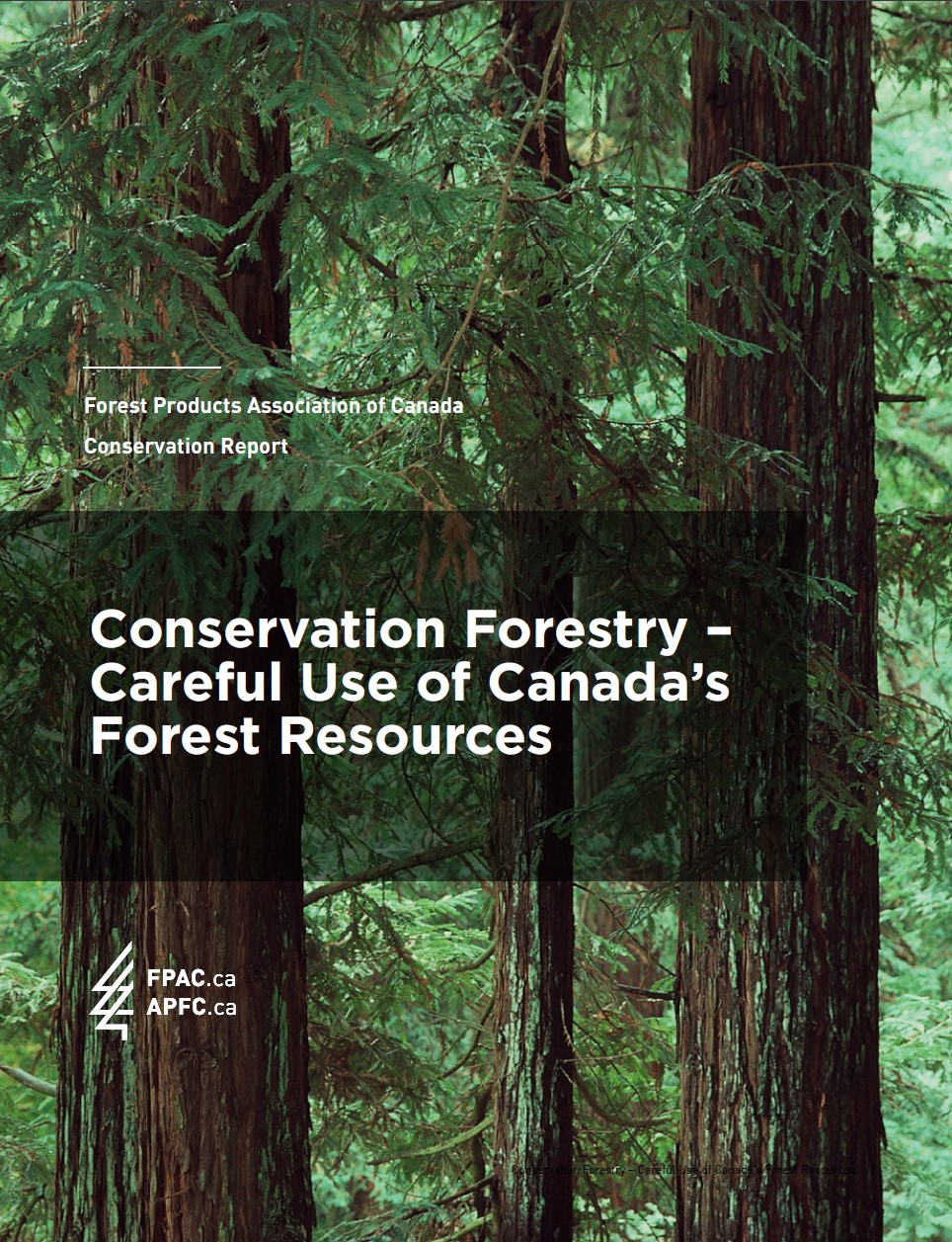Executive Summary
Canada is home to 9% of the world’s forests. The forest products sector plays an important role in the Canadian economy, and directly employs more than 184,000 Canadians.
The forest products sector also has an essential role to play in the transition to a low-carbon economy. Forests are powerful engines for sequestering carbon: as trees grow, they absorb significant volumes of it. When trees are harvested, carbon is locked into the wood over the long term. Long- lived wood products, such as construction materials, keep carbon out of the atmosphere for decades or centuries. Recycling or reusing forest products can prolong the time carbon is stored.
When examining the forest products sector’s direct carbon emissions relative to the indirect emissions from the forest product value chain, less than 10% of total value chain emissions are within the industry’s direct control. Most of the emissions originate either upstream from forest disturbances such as wildfires, or downstream from end-of-life disposal. While the forest products sector will focus on addressing emissions and carbon removals within its direct control, the sector strongly believes that significant emissions reductions can occur in the value chain through collaboration and partnership.
Harnessing the Climate Change Mitigation Potential of Climate-Smart Forestry
Climate-smart forestry consists of three main components.
• Increasing carbon storage in forests and forest products, in conjunction with other ecosystem services, such as protecting biodiversity and water quality. Central to this practice is promoting global afforestation efforts and preventing deforestation. Legal mandates in Canada to regenerate harvested areas and federal commitments to plant 2 billion trees are important steps to achieving this. Additional steps, such as research on optimal tree varieties and planting locations, and efficient nurturing of seedlings, are also required.
• Using wood resources as a sustainable substitute for nonrenewable, carbon-intensive materials. Forest products store carbon while in long-term use and, in some cases, following disposal. They can also replace more emissions-intensive materials. Steel and concrete produce a lot of carbon emissions. Wood does not. Canada needs a national strategy to increase the number and variability of mass-timber construction projects. We have seen examples of mass-timber construction not only in large buildings, but also in infrastructure projects, such as bridges. To increase the use of mass-timber techniques, the sector will need access to appropriate amounts of wood fibre and to systematically develop expertise on building with wood at scale. An effective Canadian strategy would include workforce issues as an integral component.
• Enhancing forest health and resilience through climate change adaptive forest management, i.e., reducing susceptibility to natural disturbances. This can include promoting species diversity and planning forest management around natural disturbance risks. In forests with low natural disturbance rates, trees can continue to sequester and store carbon for a long time. To reduce the risk of this carbon being released through natural disturbances, some areas will need to be harvested. In other cases, helping restore natural disturbance processes, such as through prescribed burning, will ensure that forests are less susceptible to wildfires and insect infestations.
A Roadmap Toward Net-Zero for Canada’s Forest Products Sector
There are a range of opportunities to reduce emissions within the forest products sector, as well as across the forest-products value chain. There are also important opportunities to build the resilience and carbon sequestration capacity of our forests.
There are three key emission reduction pathways for the forest products sector and partners, which are described in detail below. These pathways include setting future emission reduction targets and identifying the actions that will have the most impact.
1. Reducing operational emissions in the forest products sector.
Taking a full life-cycle perspective, carbon emissions from forestry operations activities are relatively small. It is nonetheless important to the sector to lead by example and make these operations as carbon — and economically — efficient as possible. The key emissions-generating activities that the sector can directly control and is accountable for include those associated with forest harvesting and forest renewal operations, transportation, and manufacturing. The processing of wood into usable materials is energy intensive. This is especially true for pulp and paper. Despite these challenges, Canada has already reduced its emissions from pulp and paper operations by 55% from 1990, primarily by decreasing fuel consumption and switching to alternative fuels such as biomass.
2. Increasing carbon stored in forest products and substituting forest products for more energy-intensive materials.
To build is to make choices. Shifting production to more wood products is an effective climate change mitigation strategy. Forest products, especially long-lived ones such as those used in construction, can store carbon for years, decades, or even centuries. In addition, forest regeneration mandates mean that, as timber is harvested for wood products and felled trees are replaced with seedlings, significant amounts of additional carbon will be removed from the atmosphere.
In addition, improving the recovery, recycling and reuse of forest products can extend the length of time that the carbon is stored in products. It also diverts these products from the landfill, where methane (a greenhouse gas 30 times more potent than carbon dioxide) is released over time as products decay.
Finally, substituting forest products for other materials that are more emissions intensive and scaling up the bioeconomy can help decarbonize other sectors. The process of shaping wood into a form that is usable in construction emits relatively few carbon emissions, especially when compared to materials such as steel and concrete. Forest products are also extremely useful in building retrofits. One study estimated that substituting conventional building materials with wood in half of new urban construction worldwide could provide almost one tenth of global emissions reductions needed to meet 2030 targets. Substituting biomass for fossil fuels such as coal and natural gas could also have a significant impact.
3. Increasing the resilience and carbon sequestration capacity of managed forests.
Keeping forests vibrant and growing is essential to the health of Canada’s economy and environment — and to our potential for mitigating climate change. Canada can adopt a number of practices and activities that will bolster our forests’ capacity to sequester carbon as well as build resilience to climate change, including:
• Building forest resilience through climate-smart forestry practices
• Increasing forest area through afforestation
Conclusion
The forest products sector is in a unique position to make a significant contribution to Canada’s net-zero goals.
FPAC estimates that, with the rapid adoption of new technologies, appropriate investments and new policies, the forest products sector could contribute 18 to 46 million tonnes CO2e in emission reductions annually (relative to current emissions) by 2050. In addition, climate-smart forestry practices will make our forests more resilient and help us mitigate climate change. While the sector is well positioned to take the lead on many fronts, collaboration across the entire value chain, from the forest to product disposal, and across many other sectors will be required to ensure success.
Reducing forest-related emissions is difficult, but essential. The forest products sector is ready to rise to the challenge. It is already undertaking active steps to reduce its own emissions. It also stands ready and willing to collaborate with others on reducing the emissions that are outside its direct control. The roadmap outlined above will go a long way to achieving the industry’s carbon reduction goals. Canada’s forests can continue to serve as its first line of defense against climate change and be the foundation for a more sustainable future for all.







